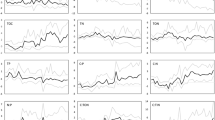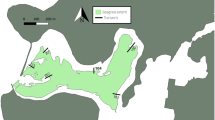Abstract
Recent sediments of the North American Great Lakes are inhabited by numerous species of macrobenthos which alter the physical and chemical properties of sediments and modify interface transport characteristics. Distributions of such radionuclides as cesium-137, lead-210, and isotopes of plutonium exhibit a zone of constant activity extending down from the sediment-water interface from 1 to 15 cm. Recent studies have confirmed that radiometrically determined mixed depths are consistent with the vertical distribution of oligochaete worms and the amphipod,Pontoporeia hoyi. Generally, 90% of the benthos are contained within the radiometrically defined mixed zone. Where comparisons are possible, rates of sediment reworking by ‘conveyor belt’ species are comparable to or exceed sedimentation rates. Systematic variations in the mixed depth occur within depositional basins with greatest depths tending to be associated with least consolidated, organically rich materials.
A quantitative steady-state mixing model accounts satisfactorily for observed radioactivity and heavy metal profiles. Bioturbation appears to be an important process, limiting the resolution with which historical records of particle-associated contaminants may be reconstructed from sediment cores. As bioturbation serves to maintain contact of contaminated sediments with overlying water, this time may also characterize the long-term lake recovery for contaminants removed by burial. As the time varies with location, a mean for an entire lake is not well known, but is on the order of 20 years for Lake Huron.
Similar content being viewed by others
References
Appleby, A. G. & Brinkhurst, R. O., 1970. Defecation rate of three tubificid oligochaetes found in the sediment of Toronto Harbour, Ontario. J. Fish. Res. Bd Can. 27: 1971–1982.
Barry, P. J., 1973. Estimating dose commitments to populations from radioactive waste disposals into large lakes. In: Environmental Behavior of Radionuclides Released in the Nuclear Industry, pp. 99–105. Int. Atomic Energy Agency, Vienna. IAEA-SM-172/43.
Batac-Catalan, Z., Krezoski, J. R., Robbins, J. A. & White, D. S., 1980. Distribution and abundance of zoobenthos in the muddy deposits of Saginaw Bay, Lake Huron. 23rd Conf. on Great Lakes Research of the International Assoc. for Great Lakes Research, Kingston, Ontario, May 19–22. Abstracts, p. 63.
Brinkhurst, R. O. & Jamieson, B. G. M., 1971. Aquatic Oligochaeta of the World. Univ. of Toronto Press. 860 pp.
Bruland, K. W., 1974. Lead-210 geochronology in the coastal marine environment. Ph. D. dissertation, Univ. of California, San Diego, Calif. 106 pp.
Bruland, K. W., Koide, M., Bowser, C. & Goldberg, E. D., 1975. Lead-210 and pollen geochronologies on Lake Superior sediments. Quatern. Res. 5: 89–98.
Edgington, D. N. & Robbins, J. A., 1976. Records of lead deposition in Lake Michigan sediments since 1800. Envir. Sci. Technol. 10: 266–274.
Edgington, D. N. & Robbins, J. A., 1979. History of plutonium deposition in Lake Erie sediments. 22nd Annual Conf. on Great Lakes Research of the Int. Assoc. for Great Lakes Research, May 1–3, 1979. Abstracts, p. 49.
Edgington, D. N. & Robbins, J. A., 1975. The behaviour of plutonium and other long-lived radionuclides in Lake Michigan: II. Patterns of deposition in sediments. I.A.E.A. Symp. on the Environmental Effects of Nuclear Power Generation, Helsinki, Finland (IAEA-SM/198/40), pp. 245–260
Fisher, J. B., Lick, W. S., McCall, P. L. & Robbins, J. A., 1980. Vertical mixing of lake sediments by tubificid oligochaetes. J. geophys. Res. 85: 3997–4006.
Goldberg, E. D. & Koide, M., 1962. Geochronological studies of deep sea sediments by the ionium/thorium method. Geochim. cosmochim. Acta 26: 417.
Guinasso, N. L. & Schink, D. R., 1975. Quantitative estimates of biological mixing rates in abyssal sediments. J. geophys. Res. 80: 3032.
Kemp, A. L. W., MacInnis, G. A. & Harper, N. S., 1977. Sedimentation rates and a revised sediment budget for Lake Erie. J. Great Lakes Res. 3: 221–233.
Krezoski, J. K., Mozley, S. C. & Robbins, J. A., 1978. Influence of benthic macroinvertebrates on mixing of profundal sediments in southeastern Lake Huron. Limnol. Oceanogr. 23: 1011–1016.
Lerman, A., 1970. Strontium-90 in the Great Lakes: concentration time model. J. Geophys. Res. 77: 3256–3264.
Rhoads, D. C., 1974. Organism-sediment relations on the muddy sea floor. Oceanogr. Mar. Biol. Ann. Rev. 12: 263–300.
Robbins, J. A., 1980. Sediments of southern Lake Huron: elemental composition and accumulation rates. U.S. Environmental Protection Agency, Ecological Research Series, EPA-600/3–80–080. August, 1980. 309 pp. (plus appendix, 198 pp.)
Robbins, J. A., 1978. Geochemical and geophysical applications of radioactive lead. In: Nriagu, J. O. (Ed.) The Biogeochemistry of Lead in the Environment, pp. 285–393. Elsevier/North-Holland Biomedical Press, New York.
Robbins, J. A., McCall, P. L., Fisher, J. B. & Krezoski, J. R., 1979. Effect of deposit feeders on migration of cesium-137 in lake sediments. Earth Planet. Sci. Lett. 42: 277–287.
Robbins, J. A., Krezoski, J. R. & Mozley, S. C., 1977. Radioactivity in sediments of the Great Lakes: post-depositional redistribution by deposit-feeding organisms. Earth Planet. Sci. Lett. 36: 325–333.
Robbins, J. A., Edgington, D. N. & Kemp, A. L. W., 1978. Comparative lead-210, cesium-137 and pollen geochronologies of sediments from Lakes Ontario and Erie. Quatern. Res. 10: 256–278.
Robbins, J. A. & Edgington, D. N., 1975. Determination of recent sedimentation rates in Lake Michigan using Pb-210 and Cs-137. Geochim. cosmochim. Acta 39: 285–304.
Sprugel, D. G. & Bartelt, G. E., 1976. Preliminary mass balance of plutonium in a watershed near Sidney, Ohio. In: Radiological and Environmental Research Division Annual Report, January–December, 1975. USAEC Report ANL-75–60(Pt. 3), pp. 20–22. Argonne National Laboratory, NTIS.
Thomas, R. L., Kemp, A. L. & Lewis, C. F. M., 1973. The surficial sediments of Lake Huron. Can. J. Earth Sci. 10: 226–271.
Wahlgren, M. W., Robbins, J. A. & Edgington, D. N., 1980. Plutonium in the Great Lakes. In: Hanson, W. C. (Ed.) Transuranics in the Environmental, pp. 659–683. U.S. Dept. of Energy (DOE/TIC-22800).
Author information
Authors and Affiliations
Additional information
Contribution No. 300 of the Great Lakes Environmental Research Laboratory, Ann Arbor, Michigan.
Rights and permissions
About this article
Cite this article
Robbins, J.A. Stratigraphic and dynamic effects of sediment reworking by Great Lakes zoobenthos. Hydrobiologia 91, 611–622 (1982). https://doi.org/10.1007/BF00940150
Issue Date:
DOI: https://doi.org/10.1007/BF00940150




